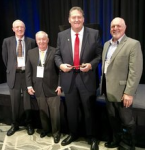Building Local Connections

When students from a local elementary school visit Port Panama City, Executive Director Alex King can predict with some confidence which part of the field trip will be their favorite.
“It’s definitely the container reach stackers by far,” he said. “They just can’t get over the sight of these big machines reaching up, locking in, picking up a container, raising it 50 feet in the air, and setting it on top of another one. They think it’s the best way to play Tetris.”
Handling more than 2 million tons of cargo a year and generating about 11,000 jobs, Port Panama City is an integral part of the Florida Panhandle, an economic driver poised for growth. The port will break ground on a second warehouse this year, part of a $60 million expansion of its East Terminal. A 600-foot berth extension and expansion of the turning basin there is in the permitting stages, with construction expected to begin in 2027.
With big plans in place, Port Panama City needs a skilled local workforce that recognizes the port as an engine of opportunity, so King and his team are reaching out to students of all ages. That includes hosting field trips for children and developing educational curriculum for older students, he said.

Young students visiting the port get hard hats and safety vests as they enter a conference room, where they enjoy a snack and view an animated presentation geared toward their age level. The slides display the steps along the supply chain for products such as cucumbers imported from Mexico, with the arrival of the ship to the port, the removal of the containers, the loading of products onto rail or trucks and, finally, their arrival on grocery-store shelves.
From there, students get on a bus and tour the port, which includes watching containers get loaded, unloaded, and stacked. Students can climb into the driver’s seat of large cranes, reach stackers and forklifts to “get a feel for the immense size of this equipment and what it does,” King said. Students also tour the warehouse and see the various types of commodities and finished products shipped into and out of the port every day.
“We tell them that operating a crane is kind of like playing video games except it’s not virtual, it’s real,” King said. “We talk about how the things they use in their daily lives come through ports so they understand that what we’re doing right here in Panama City affects their lives and affects the world.”
Port Panama City also regularly hosts students from Junior Leadership Bay, a program run by the Bay County Chamber of Commerce designed to educate high school juniors about the resources and career opportunities available in Bay County.

To prepare older students for careers there, Port Panama City is working with administrators from two schools in Panama City — Gulf Coast State College and Tom P. Haney Technical College — to establish relevant courses. The port also has visited local schools to talk about job opportunities and asked educators for help in identifying mechanically inclined students who might want to work at the port.
“Terminal handling equipment is getting more and more sophisticated,” King said. “It’s a lot less pulling levers and a lot more programming and drive systems, so we need to prepare our local workforce for that.”
King and his team spend considerable time building community connections. He’s active with two local chambers of commerce and an environmental group focused on the health of local estuaries. Looking ahead, the port will work with local environmental groups and stakeholders to establish new seagrass beds, mitigating the environmental impact of the major construction project to expand the East Terminal.
“Our outreach is really going to pick up with this expansion,” King said. “If you have the community involved and invite them to be a part of it, then they’ll want it to be successful too.”
Setting Sail in Oakland
If you want a free guided tour of Oakland’s inner and outer harbors, you have to act fast. Once a month from May through October, the Port of Oakland takes about 250 passengers on an educational ferry ride, passing under the western span of the San Francisco-Oakland Bay Bridge near Yerba Buena Island before returning to Jack London Square, a vibrant hub of outdoor recreation, dining and entertainment venues.
During the 90-minute tour, live narration teaches visitors about the global economic impact of the port’s operations, and passengers get an up-close view of container cranes, megaships, and terminal activity.
Sound interesting? You’re not alone in thinking so. Two weeks before each sailing, the Port of Oakland makes tickets available on its website, and they’re typically gone in minutes, according to Matt Davis, chief public engagement officer for the port.
“These sailings are always oversubscribed, and people show up to be put on a waiting list in case some people with tickets don’t show up,” he said.
Competition is equally fierce for a summer internship at the Port of Oakland. After a hiatus during the pandemic, the port restarted its internship program two years ago, and it recently received more than 600 applications from college students for 22 positions, Davis said. Interns earn a healthy salary of $25 an hour, work up to 25 hours a week and are spread throughout the port’s departments, including engineering, government affairs, aviation, and maritime logistics.
“That’s a pretty good wage for a college student,” Davis said. “It’s a lot more than I made when I was in college, and it’s a hands-on opportunity for students to work on substantive projects. We really incorporate them into port operations so they can gain meaningful career experience. We’re starting to see former interns come back to the port as employees, which is really gratifying. We want to attract the best and brightest workers.”

Each quarter since 2015, the Port of Oakland’s Community Investment Program has awarded grants of up to $5,000 to local nonprofit organizations. To qualify, a group’s purpose must align with one of the program’s three stated priorities: economic vitality, environmental sustainability and healthy communities, and workforce development and education. The grants amount to several hundred thousand dollars each year, Davis said.
Some grants help small businesses create and sustain jobs, while others improve energy conservation, water quality, and environmental stewardship. Still others prepare people for careers at the port through skills training and education.
Similarly, the points system used to determine which businesses are awarded contracts to provide products and services to the port is weighted toward small businesses in the area, allowing the local community to reap the economic benefits.
“Our goal is not to just be a source of economic activity but a source of economic opportunity,” Davis said. “We spend a lot of money every year on critical infrastructure, and we need to make sure that we have highly trained workers available so those projects are delivered on time and under budget. We’re trying to build into our processes opportunities to have the community’s success mirror the port’s success.”
Showcasing the Big Apple
Northern California’s Bay Bridge is quite a sight, no doubt, but it’s hard to compete with sunset views of the Statue of Liberty and the skyline of Lower Manhattan. Each summer, Beth Rooney, director of the Port Authority of New York and New Jersey, guides a boat tour through New York Harbor and into container terminal waterways, teaching passengers about the past, present, and future of the local shipping industry.
The annual Port Infrastructure Tour has become an important revenue-generating event for Open House New York, a cultural nonprofit group promoting broad access to the city and educating the public about what makes New York special. Though tickets cost $45 for group members and $55 for general admission, the 500 available seats “always go quickly,” and there’s a long waiting list, according to port spokesman Steve Burns.
Aboard the Circle Line ferry, passengers get a good look at towering ships, massive cranes, and cargo-handling equipment before passing by Liberty Island, home to the Statue of Liberty, and under the Bayonne Bridge. Last summer, the tour included up-close views of the MSC Lisbon, which was carrying 12,000 containers through the Kill Van Kull waterway, and the OCCL Berlin, which was docked at the Port Newark-Elizabeth Marine Terminal with more than 13,000 containers.

During the tour, Rooney explained how the Port Authority had raised the Bayonne Bridge’s roadway less than a decade ago so the world’s largest container ships could access container terminals in New Jersey and State Island. The ambitious project elevated the roadway 64 feet, placing it 215 feet above the water.
As the tour neared its end, Rooney asked passengers to reflect on how port operations affect their daily lives. “When you go home tonight and you’re getting ready for bed, look at the labels of everything you touch, whether it’s clothes, sheets or furniture,” she said. “Look where they came from. They came in on a ship through New York Harbor.”
Rooney said the boat tours are an important component of the port’s outreach efforts and typically are eye-opening for passengers.
“It’s great to see how curious people are about what goes on in the maritime industry,” she said. “We usually don’t hear about the supply chain until some part of it breaks down, but the truth is, it impacts us every day in so many ways. The more we can help people understand that, the better.”




